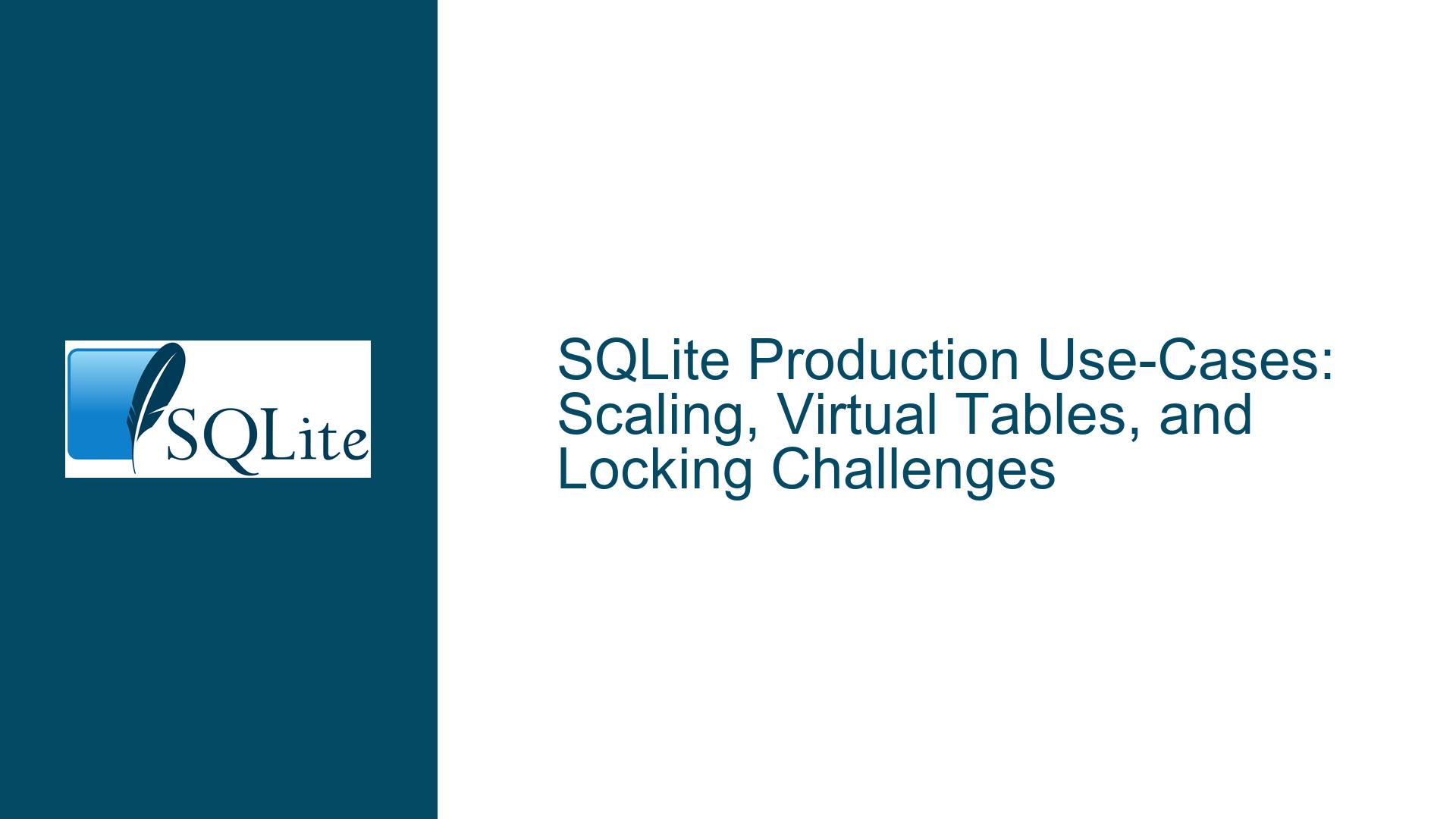SQLite Production Use-Cases: Scaling, Virtual Tables, and Locking Challenges
Production Use-Cases and Architectural Patterns
SQLite’s flexibility as an embedded database engine has made it a cornerstone of countless production systems, ranging from version control systems to game engines and network protocol servers. One of the most prominent examples discussed is Fossil SCM, which powers both the SQLite forum and its own source code repository. Fossil SCM uses SQLite not just for metadata storage but as the backbone of its entire operation, including ticket tracking, wiki pages, and versioned artifacts. The database schema is tightly integrated with Fossil’s workflow, enabling atomic commits that include code changes, documentation updates, and issue tracking modifications in a single transaction. This design eliminates the need for external coordination between disparate systems, reducing complexity and improving reliability.
Another compelling use-case is Free Hero Mesh, a puzzle game engine that leverages SQLite for user progress tracking, level editing, and in-game scripting. The engine exposes virtual tables that map directly to game entities (e.g., levels, solved puzzles, move histories), allowing users to query and manipulate game state using SQL. For example, a player might write a query to calculate the percentage of levels solved or batch-update key bindings through SQL-driven macros. This approach transforms SQLite into an extensible scripting layer, where complex game logic can be expressed declaratively rather than imperatively. The engine also employs temporary tables for combinatorial calculations, such as identifying valid combinations of graphical assets during level design. By offloading these tasks to SQLite, the engine avoids reinventing query optimizers and data structures, focusing instead on domain-specific game mechanics.
The NNTP server and client implementations mentioned in the discussion use SQLite as a persistent store for Usenet articles. Each article is stored as a row with metadata (headers, message IDs) and binary content. SQLite’s full-text search capabilities enable efficient filtering of articles by subject or author, while its transactional guarantees ensure consistency during high-concurrency posting operations. The client implementation likely uses recursive queries to manage thread hierarchies, leveraging SQLite’s support for Common Table Expressions (CTEs) to navigate tree-like structures inherent in newsgroup discussions.
A ZZT world file editor demonstrates SQLite’s utility in retrocomputing environments. By exposing ZZT’s proprietary file format as virtual tables, users can perform batch operations (e.g., mass-replacing tiles, modifying enemy behavior) through SQL queries. This abstraction layer simplifies reverse-engineering tasks, as SQL’s expressive syntax replaces low-level byte manipulation. Virtual tables here act as bidirectional adapters, translating SQL operations into file format-specific writes while presenting a relational interface to the user.
Underpinning these use-cases are recurring architectural patterns:
- Embedded Configuration and State Management: Applications like Firefox (via its bookmark storage) and Fossil SCM use SQLite as a local configuration store. The database’s portability ensures that user-specific data (e.g., solved game levels, editor preferences) remains consistent across installations.
- Virtual Tables as Abstraction Layers: By implementing virtual tables, applications expose internal data structures (game entities, file formats) as queryable tables. This pattern shifts complexity from application code to SQL, enabling users to leverage SQLite’s optimizer for tasks like JOIN-heavy queries or recursive traversals.
- SQL as a Scripting Language: Custom key bindings and macros defined in SQL allow end-users to extend application behavior without modifying source code. This is particularly powerful in tools like Free Hero Mesh, where SQL queries can trigger in-game actions or modify UI elements dynamically.
Common Challenges in Scaling and Custom Implementations
Despite SQLite’s versatility, scaling it in high-concurrency environments or custom implementations introduces challenges. Locking contention is a recurring issue, particularly in networked applications like the Fossil SCM web interface. When multiple users attempt simultaneous writes (e.g., editing wiki pages or submitting tickets), SQLite’s write-ahead logging (WAL) mode mitigates but does not eliminate lock conflicts. Fossil’s infrequent locking errors (5–10 instances over 15 years) suggest a combination of optimistic concurrency control and short-lived transactions. However, applications with heavier write loads—such as a NNTP server handling thousands of concurrent posts—might experience more frequent lock contention, necessitating careful transaction design.
Eponymous virtual table performance presents another challenge. In Free Hero Mesh, the “lazy table” pattern involves creating a temporary table during query execution, then forcing a recompile by returning SQLITE_SCHEMA. While effective for on-demand data loading, this approach incurs overhead when the virtual table is accessed frequently. The discussion notes that dropping an eponymous virtual table is slower than dropping a temporary table, likely due to SQLite’s internal schema validation steps. Eponymous tables require the database engine to check for schema changes across all connections, whereas temporary tables are connection-specific. This overhead becomes pronounced in applications that dynamically create/drop virtual tables as part of their workflow.
Horizontal scaling remains SQLite’s most debated limitation. The forum participant’s vague reference to an “engineering secret” hints at sharding or replication strategies built atop SQLite. For instance, a distributed system might partition data by user ID, with each shard residing in a separate SQLite database. However, coordinating cross-shard transactions or maintaining global indexes becomes the application’s responsibility. Alternatives like SQLite-backed distributed key-value stores (e.g., using SQLite as a storage engine for each node in a RAFT cluster) can provide horizontal scalability but require significant infrastructure investment.
Custom virtual table implementations risk data integrity issues if not carefully designed. The ZZT editor’s virtual tables must faithfully map SQL operations to the ZZT file format, which lacks native support for transactions or atomic writes. A failed UPDATE could leave the file in a corrupted state unless the virtual table employs defensive copying or journaling. Similarly, the NNTP server’s article storage must handle binary blobs efficiently; excessive use of BLOB types without application-level caching can lead to memory pressure during large article retrievals.
Optimizing SQLite for High-Performance and Reliability
To address locking contention, WAL mode with busy_timeout is essential. Fossil SCM’s low lock error rate likely stems from configuring PRAGMA busy_timeout to allow retries before returning SQLITE_BUSY. For write-heavy workloads, combining WAL with page-level locking (via PRAGMA locking_mode=EXCLUSIVE) reduces contention but sacrifices concurrent reads. Applications should also minimize transaction durations—batch writes into fewer transactions and avoid holding transactions open during user interaction.
Optimizing virtual tables requires caching and incremental materialization. Free Hero Mesh’s “lazy table” could benefit from materializing the temporary table once and incrementally updating it as underlying data changes, rather than rebuilding it on every access. Implementing the xBestIndex method in virtual tables allows SQLite’s query planner to make informed decisions about index usage, reducing full-table scans. For example, a virtual table representing ZZT world tiles might expose positional columns (X, Y) and declare them as indexed, enabling the planner to push down WHERE x BETWEEN 10 AND 20 predicates to the virtual table implementation.
For horizontal scaling, application-level sharding is a proven strategy. A user directory service could partition users alphabetically, storing each letter’s subset in a separate SQLite database. Cross-shard queries are handled by aggregating results from multiple databases, akin to MongoDB’s federated queries. Tools like Litestream or SQLite VFS for cloud storage enable offloading backups/archives to object storage, providing durability without compromising local write performance. However, true horizontal write scaling requires embracing eventual consistency models, which SQLite’s ACID semantics don’t natively support.
Eponymous virtual table overhead can be mitigated by avoiding frequent DDL operations. Instead of dropping and recreating tables, applications should truncate or reuse existing temporary tables. In Free Hero Mesh’s case, replacing DROP TABLE with DELETE FROM temp.table_name followed by VACUUM (if fragmentation is a concern) reduces schema change notifications. Additionally, using CREATE TEMP TRIGGER to auto-refresh materialized views on data changes eliminates the need for manual recompilation via SQLITE_SCHEMA.
To ensure data integrity in custom file format adapters (e.g., ZZT editor), shadow paging provides atomic updates. Before modifying the file, the virtual table copies the active data to a shadow page. All writes occur on the shadow copy, which is atomically swapped with the live data via an fsync-guarded rename operation. This approach mirrors SQLite’s own rollback journal mechanism, providing crash resilience without relying on the host file system’s transactional capabilities.
Finally, leveraging SQLite’s extensions enhances functionality without reinventing the wheel. The JSON1 extension enables schema-less data storage in columns, useful for NNTP article metadata that varies by newsgroup. Geospatial applications can integrate with SpatiaLite for GIS queries, while the FTS5 extension accelerates full-text search in documentation-heavy systems like Fossil SCM’s wiki. By building atop these extensions, applications delegate complex operations to battle-tested code, reducing bug surface area.






